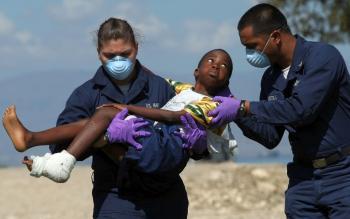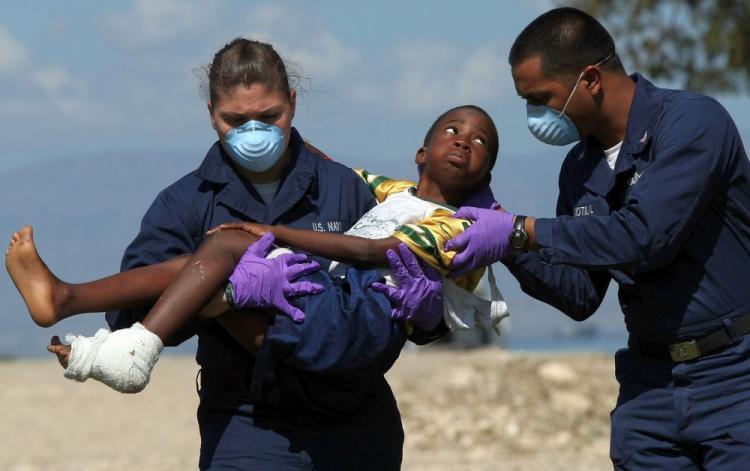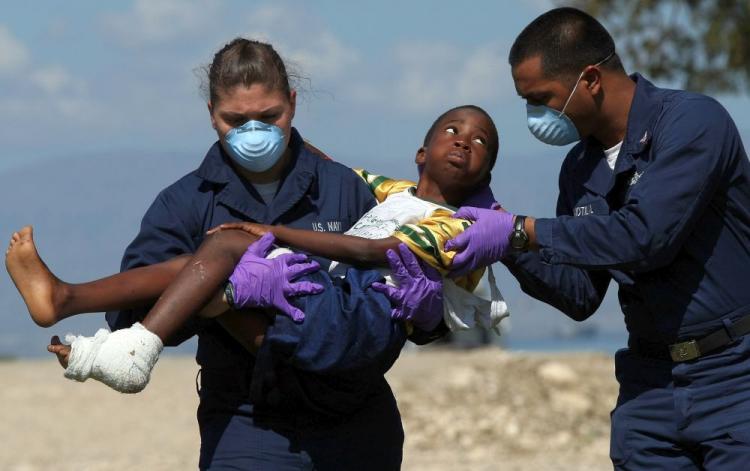“My concern is that we’re not able to mobilize quickly enough to address the needs of the most vulnerable people,” said Steve Hollingworth, chief operating officer of CARE, by satellite phone from Port-au-Prince on Thursday.
Aid organizations must engage local communities and communicate well with each other to improve and strengthen coordination efforts among groups.
“It’s very important to go to communities beforehand and speak with everybody, including the authorities, such as the mayors, so that people understand how much aid is coming and who it’s aimed at,” said Hollingworth.
They also need to have a role in organizing the people and the distribution site and understand that the priority must go to the most vulnerable people, he said. “It can increase tension if it’s not done that way.”
On Wednesday, another aftershock struck near the Haitian capital, further devastating the small Caribbean country, where the death toll is now estimated to be at least 200,000.
The latest 5.9-magnitude quake was the strongest tremor since the massive 7.0-magnitude earthquake traumatized the Western Hemisphere’s most impoverished nation on Jan. 12.
“It’s difficult to see 1.5 million people living on the streets, in temporary shelters,” said Myriam Fehmiu, communication adviser with Montreal, Canada-based CECI, the Center for International Studies and Cooperation. “As the aid is not coming fast enough, ‘temporary’ could mean months in very precarious conditions.”
{ntdtv http://english.ntdtv.com/ntdtv_en/ns_asia/2010-01-21/191300237112.html}
The homeless and displaced, by the thousands, are living in schools, university campuses, central plazas, parks, and golf courses, in front of the presidential palace, even at the prime minister’s office.
CECI notes that tents and shelters are urgently needed before the rainy season starts.
Like Hollingworth, Fehmiu arrived in Haiti last Saturday as part of her organization’s humanitarian convoy. Her group brought five tons of aid, including water, food, and kitchen kits. CECI began to distribute water the same day.
“In one distribution point, it was the first time they got aid since the earthquake, so from [last] Tuesday to Saturday, it was the first time they received water and food,” Ms. Fehmiu said.
“CARE has had many successful distributions, but the aid is not enough and the ability of people to cope in their situation is deteriorating,” Hollingworth said.
CARE has 150 people working in Haiti and is trying to get aid into four large areas that have a population of between 700,000 and 800,000 people, he said.
The quake devastated everything from vehicles, gas stations, and phone networks to homes, schools, hospitals, and other buildings, including the presidential palace, the Parliament building, U.N. headquarters, and the small international airport.
“There is a big humanitarian effort with the shipment of supplies to the airport, but there’s a bottleneck at the airport and it’s difficult to get supplies out to the communities,” said Hollingworth.
“There are many challenges,” he said, listing communication, fuel, and congestion among them, along with a Haitian government that is in charge but has “become very weakened” by the earthquake.
U.N. agencies are leading a system of “clusters” to coordinate international assistance.
There are currently 12 clusters in place that deal with different expertise such as water and sanitation, housing, medical care, psychosocial rehabilitation, and search and rescue.
Regarding the latest aftershock, Hollingworth said, “The bigger concern is that so many people here have experienced so many of them that it raised the level of anxiety and trauma.”
“People are picking themselves up. People are very strong and resilient,” he said, but noted that Haiti will need humanitarian assistance for many years.
“The work is huge, the catastrophe is huge. I don’t find the words yet to explain how big the reconstruction will have to be and how huge the immediate efforts are that need to be done,” Fehmiu said.
Despite “challenges with coordination, which are inevitable given how much destruction everything has had [in Haiti],” Hollingworth urged aid groups to respect the rules and standards of humanitarian response, which ask for engagement with local communities and good inter-communication.
“The U.N. system is designed for those two things to happen. If we all act in that way, the aid effort will pick up very aggressively,” he said.






